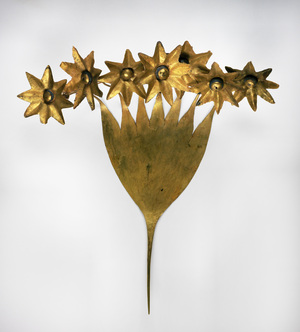
I found the intact tomb, stone built and vaulted over with bricks of Queen Shubad adorned with a dress in which gems, flowers, crowns and animal figures are woven. Tomb magnificent with jewels and golden cups. Woolley.
This ornate headdress and pair of earrings were found with the body of Queen Puabi in the Royal Cemetery at Ur. The headdress is made up of 20 gold leaves, two strings of lapis and carnelian, and a large gold comb. In addition, she wore chokers, necklaces, and large lunate-shaped earrings. Her upper body was covered by strands of beads made of precious metals and semiprecious stones that stretched from her shoulders to her belt. Ten rings decorated her fingers. A diadem or fillet made up of thousands of small lapis lazuli beads with gold pendants depicting plants and animals was apparently on a table near her head. Two attendants were in the chamber with Puabi, one crouched near her head, the other at her feet. Various metal, stone, and pottery vessels lay around the walls of the chamber.
Her tomb was intact and its contents typical of the wealth found throughout the royal cemetery. Like the other royal tombs, it consisted of a chamber set at the bottom of a deep pit accessed by a ramp. (Woolley dramatically dubbed these "death pits" because of the human "victims" they contained.) The vaulted chamber, made of limestone rubble, lay at the northeast side of the pit. It measured about 9 feet by 14 feet, with the ceiling 5 feet above the floor. Puabi's body lay on a wooden bier in the chamber.
Expedition - Powerful Women of Ur
In ancient Mesopotamia, women filled many roles that brought strength to their communities. Among these women were a few in the city of Ur, who held powerful positions as rulers and religious leaders. Watch as Penn Museum experts, William B. Hafford, Ph.D. and Jane Hickman, Ph.D. bring to light the stories of Queen Puabi and the Entu Priestesses.

What's in a Name?
Her name and title are known from the short inscription on one of three cylinder seals found on her person. Although most women’s cylinder seals at the time would have read "wife of ___," this seal made no mention of her husband. Instead, it gave her name and title as queen. The two cuneiform signs that compose her name were initially read as "Shub-ad" in Sumerian. Today, however, we think they should be read in Akkadian as "Pu-abi" (or, more correctly, "Pu-abum," meaning "word of the Father"). Her title "eresh" (sometimes mistakenly read as "nin") means "queen."
In early Mesopotamia, women, even elite women, were generally described in relation to their husbands. For example, the inscription on the cylinder seal of the wife of the ruler of the city-state of Lagash (to the east of Ur) reads "Bara-namtara, wife of Lugal-anda, ruler of the city-state of Lagash." The fact that Puabi is identified without the mention of her husband may indicate that she was queen in her own right. If so, she probably reigned prior to the time of the First Dynasty of Ur, whose first ruler is known from the Sumerian King List as Mesannepada. Inscribed artifacts from the Seal Impression Strata (SIS) layers above the royal tombs at Ur name Mesannepada, King of Kish, an honorific used by rulers claiming control over all of southern Mesopotamia.
The Royal Tombs of Ur
In the 1920s, the Royal Cemetery of Ur excavations became one of the great technical achievements of Middle Eastern archaeology and now represents one of the most spectacular discoveries in ancient Mesopotamia (modern-day Iraq). Deep within the site lay the tombs of the mid-3rd millennium BCE kings and queens of the city of Ur, famed in the Bible as the home of Biblical patriarch, Abraham. The tombs date to the period known as the Early Dynastic IIIA period (2600-2500 BCE), a high point in the history of Sumerian culture.
The renowned excavator of the cemetery was British archaeologist C. Leonard Woolley, later Sir Leonard Woolley. In all, Woolley uncovered some 1,800 burials. He classified 16 as royal based on their distinctive form, their wealth, and the fact that they contained the burials of household servants, male and female, along with clearly high-ranking personages.
Object Records









Found in the Field
On January 4, 1928, the Museum received a telegram from Leonard Woolley announcing his great find of the tomb of Queen Puabi, at that time translated as Queen Shubad. Not wanting to attract undue attention (because telegrams were transcribed by individuals), the message is written in Latin.


Treasures From the
Royal Tombs of Ur
This stunning catalogue includes color photographs of more than 230 objects, excavated in the 1930s by renowned British archaeologist Sir Leonard Woolley, from the third-millennium-B.C. Sumerian city of Ur. Learn the fascinating story of the excavation and preservation of these magnificent artifacts.
Buy This BookOnline Resources
Ur Online
Videos
Expedition Magazine
- A Telegram of Discovery from Ur
- Ur and Its Treasures: The Royal Tombs
- What Do We Know About the People Buried in the Royal Cemetery?
Penn Museum Blog
